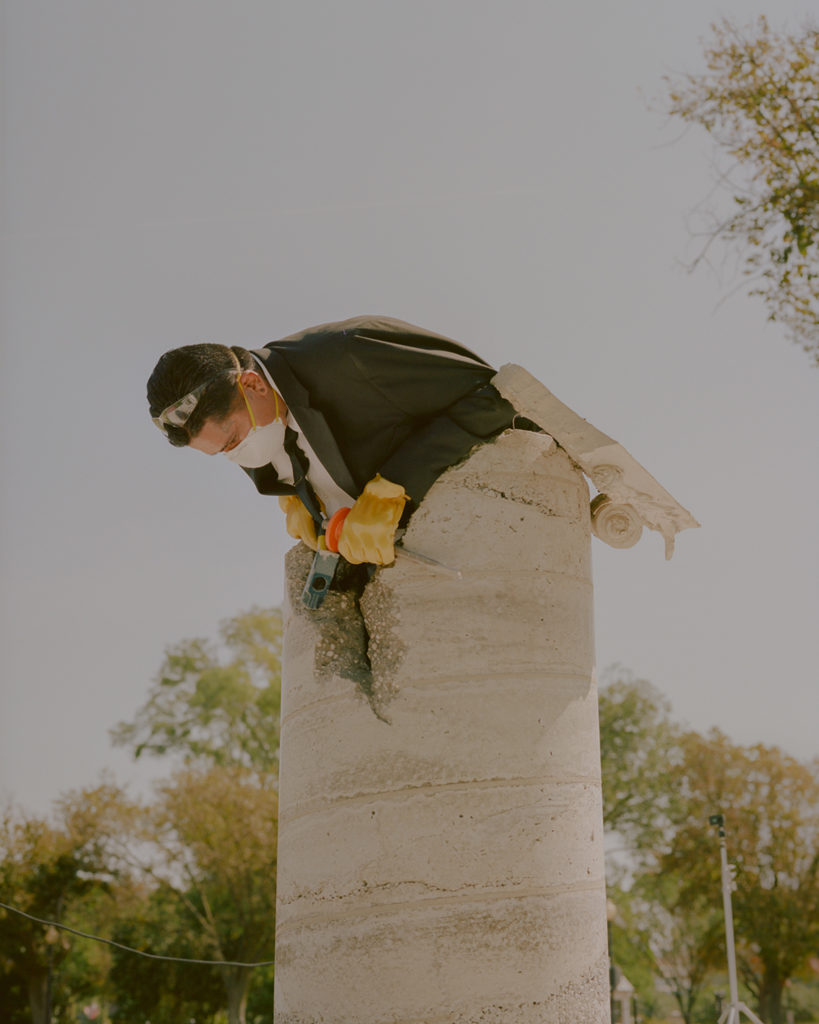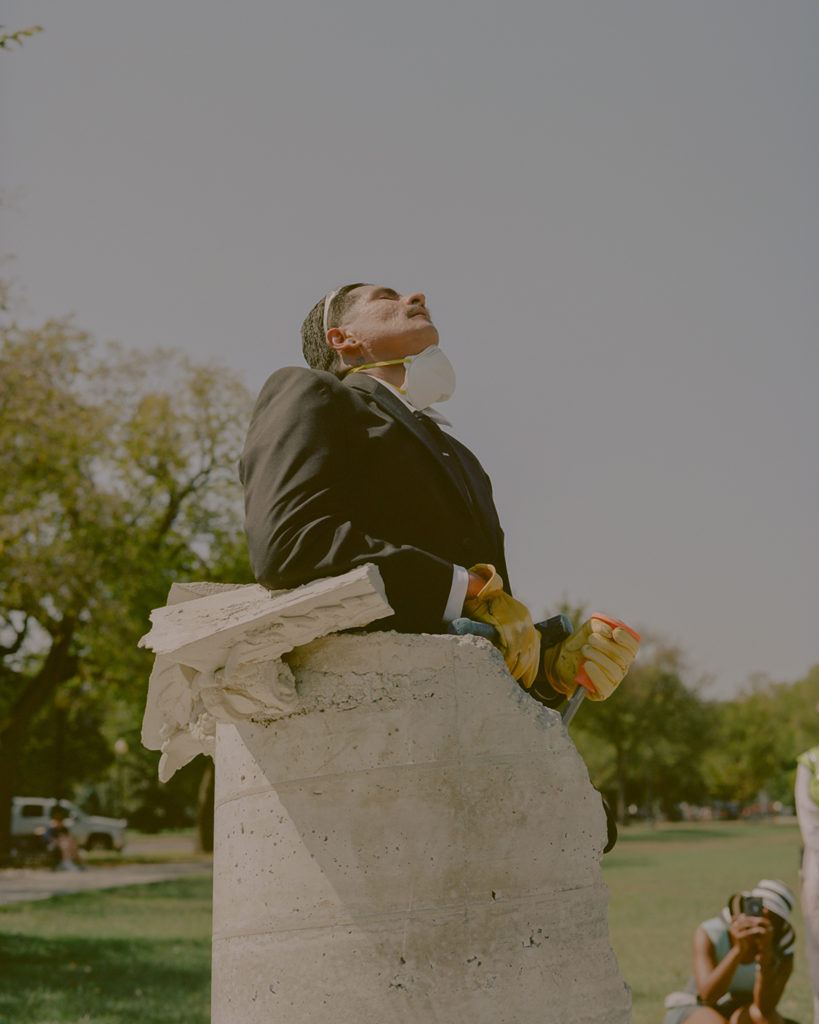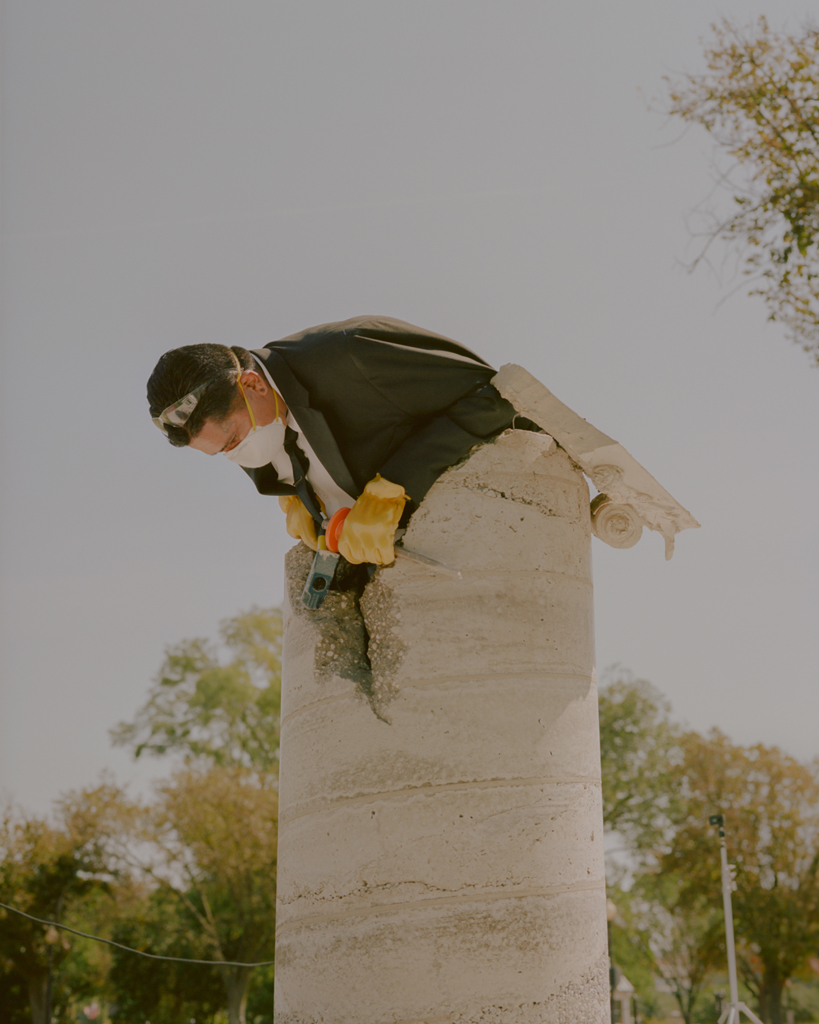[ad_1]

Performance view of rafa esparza’s bust: indestructible columns, 2019, in Washington, D.C.
©NATALIA MANTINI
From its very beginnings, art history has been a discipline with a reverence for Greek culture. In 1748 the German scholar Johann Joachim Winckelmann was hired as the librarian to Count von Bünau, a statesman in the Holy Roman Empire who owned more than 42,000 volumes that included classics. This excited the young Winckelmann, a Grecophile who proclaimed in an essay that “the only way for us to become great, or even inimitable if possible, is to imitate the Greeks.” (Never mind that he had never been to Greece.)
Winckelmann is today regarded as the father of art history, and his admiration for the Hellenes extended to their art and architecture, whose greatness he attributed to a political climate that offered its citizens freedom, though it elided that their society was built on slavery. The United States, of course, has had a similarly fraught history with questions of democracy and freedom, and so it seems fitting that Greek architecture and iconography have been at the core of the self-image of the United States since its founding, their influence visible throughout the nation’s capital, Washington, D.C.
At a time when many are questioning the founding ideals of American society, one artist has reminded us of these seemingly irreparable failures of democracy: rafa esparza, whose latest performance bust: indestructible columns took place on Saturday, September 21, in Washington, examined the Western constructs of constitution and government. (The performance, presented collaboratively by Performance Space New York and Ballroom Marfa, is in two acts, and its second part, a collaborative dinner symposium, took place the following Monday in New York at Performance Space.)
esparza has previously transformed his body into an ephemeral sculpture. In April 2015 he presented bust, a meditation on freedom near the Twin Towers Correctional Facility in Los Angeles, protesting mass incarceration and the treatment of prisoners. There, in a five–cornered section of downtown Los Angeles, esparza was surrounded by bail bond strip malls and the ever-present cranes of development that signal gentrification as he slowly chipped himself out of a concrete encasement that took over three hours to break open.

Performance view of rafa esparza’s bust: indestructible columns, 2019, in Washington, D.C.
©NATALIA MANTINI
In D.C., he staged a similar version to that earlier work with bust: indestructible columns set in the Ellipse, a 52-acre park south of the White House fence and just north of Constitution Avenue and the National Mall. Here, esparza and collaborator Los Angeles sculptor Timo Fahler arrived to the site with a column, after being delayed by an inspection by Secret Service police and K-9. Once clearance was received, esparza climbed atop and slid into the hutch of the interior of the column, tightly encasing himself waist-deep into the concrete cylinder sculpted to resemble a Greco-Ionic column (made with Fahler). Dressed in a black blazer and tie reminiscent of an abolitionist orator exhorting the masses, esparza offered—instead of a speech—the shrill cry of a mallet pounding the chisel. These were the tools that he used to destroy the column’s concrete structure.
For almost two hours facing the White House, esparza hammered away as he attempted to free himself. With each spatter of concrete chunks falling from the column onto a tarp, Secret Service Police sternly warned members of the neon yellow–vested support team that the performance would be shut down if the pieces touched the grass. Tourists strolling through stopped and asked what esparza was doing—and why. “He’s protesting the children in the cages,” one audience member offered.
In the process, the artist chipped away at the falsehoods of democracy and its promises of freedom that are often left unfilled. esparza was deconstructing the “literal support systems for the structures that have housed and given an image of dominance to a legacy of white supremacist governance,” he told ARTnews. “The White House, whose porticoes are lined with such columns, now houses the 45th president, whose rhetoric has aided in the inhumane violence of separating families, caging children, detaining adults in intolerable conditions, and instigating hate crimes.”

Performance view of rafa esparza’s bust: indestructible columns, 2019, in Washington, D.C.
©NATALIA MANTINI
In 1852 Frederick Douglass delivered the speech “What to the Slave is the Fourth of July?” in a premier speaking venue in Rochester, New York: Corinthian Hall, named after the Greco-Corinthian columns that adorned its stage. In his speech Douglass invoked the conditions the founding fathers were subjected to as subjects of the Crown, the colonial children of a British monarchy that claimed God gave it power.
“Your fathers,” Douglass wrote, “went so far in their excitement as to pronounce the measures of government unjust, unreasonable, and oppressive, and altogether such as ought not to be quietly submitted to. … Oppression makes a wise man mad. ” But these founding fathers did not go mad. They became impatient under this treatment, seeing themselves as victims of grievous wrongs, incapable of continuing as colonial subjects of British rule.
With bust, esparza seemed to echo the language of Douglass’s famed speech, which asks us to consider the ways in which celebrations of American’s founding fathers and democratic ideals become the mockeries that Douglass himself and his enslaved brethren endured—they who, in addition to building the White House, were still expected to celebrate the birth of the nation, even as their still yet unpaid labor built this nation. Or else.
On hand for esparza’s performance was curator and writer Risa Puleo, artist Sebastian Hernández, poet and activist Yosimar Reyes, and myself, all invited by the artist to witness the D.C. event and read texts during its second staging in New York. “What does liberty mean when the context of your life makes life unlivable?” Puleo asked at one point. On the flight to New York for the second-half of bust, I thought of the images of children in cages and kennels in Tornillo, Texas; Lordsburg, New Mexico; and Eloy, Arizona—towns through which I have driven while going down the interstate that connects California to Texas.
Puleo continued: “In 2019, what do republic and democracy mean to the migrant? Liberty exists in relation to sovereign power and is a fallacy when positioned with a biopolitical schema. Is the migrant ever really out of the cage? She may be released from the physical structure, but not the structural systems that created them in the first place.” These questions madden. The inquiry lives on in the exhausted body of the artist in angry stillness, now freed from the physical structure at the center of bust.
For esparza, these power structures emerge in the everyday. In a recent Instagram post he narrates a recent aggression he witnessed in preparation for bust in Washington at a hardware store, where, with Fahler, he encountered a group of white men verbally taunting and threatening to call ICE on brown day laborers. The artist writes, “This is what this nation is built on and what this country is made of.”
[ad_2]
Source link

